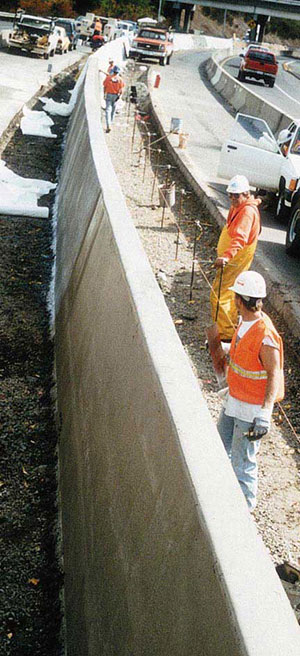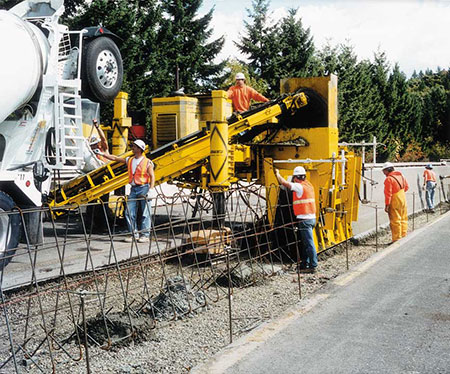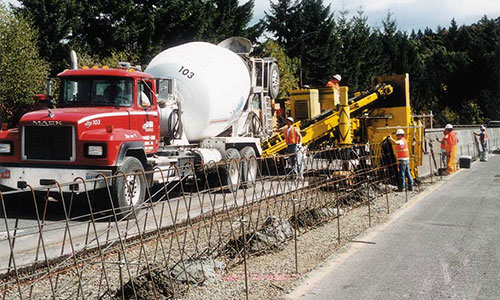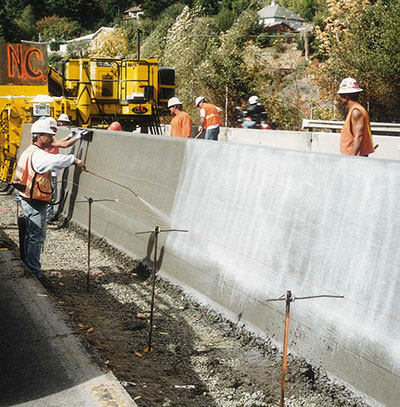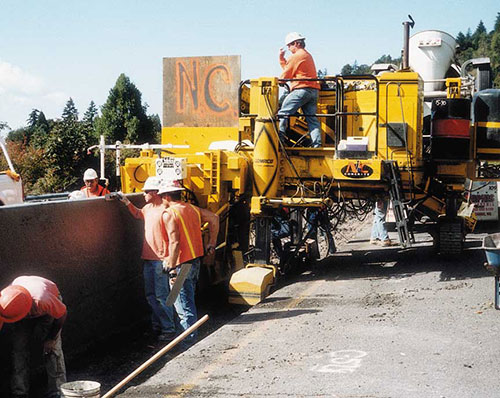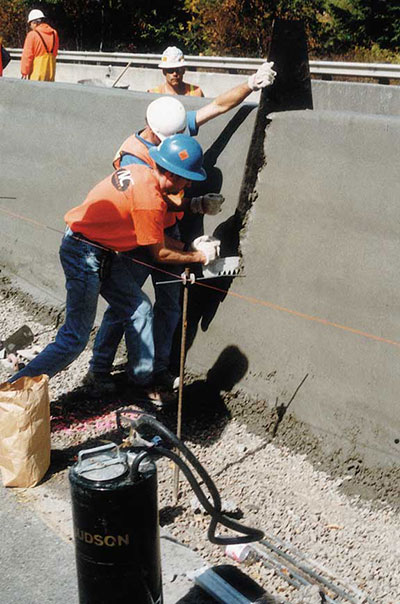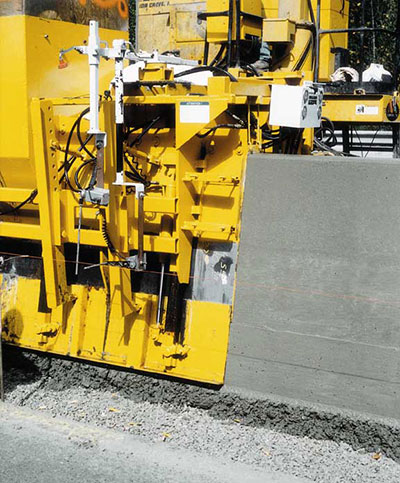GOMACO World Index --- GOMACO World 28.2 - August 2000
Working Wonders
N.C. Concrete in Vancouver, Washington, started their curb and gutter and sidewalk business two years ago with a GT-3600. They expanded their capabilities last year to include freeway safety barrier and started with a challenging project.
Work on N.C. Concrete's first barrier project began on Highway 14, east of Vancouver. The existing highway guard rail was replaced with 3029 feet (923 m) of cast-in-place concrete barrier.
"This was a fast-track job and we were on a critical schedule," Jerry Nutter, vice president of N.C. Concrete, said. "We knew slipforming would be much faster than the traditional cast-in-place method, so we had GOMACO build us a special mold and we took the chance we could slipform the wall."
The company needed a mold 70 inches (1778 mm) tall that could taper down to 38 inches (965 mm) to meet project specifications. GOMACO built them a mold with a hydraulically-adjustable profile that allowed for the variations in wall height.
"We started slipforming the tallest part of the wall at 70 inches (1778 mm) and then it tapered down to a 38 inch (965 mm) barrier," Jim Creagan, concrete division manager, said. "There was one section where we had to go over an existing overpass. Because the mold had varying sides on it, we slid the bottom of the mold up inside itself, and poured over the existing structure. When we were done, we dropped the sides of the mold back down. The top of the wall was standing at the same elevation all the way."
The wall was eight inches (203 mm) wide at the top and over 36 inches (914 mm) at the bottom. It was slipformed over steel reinforcing with vertical bars 18 inches (457 mm) on center with horizontal bars every eight inches (203 mm) on both sides.
"We spent the first day of the project dry running the machine over the rebar. As we dry ran the rebar with the machine, we cow pied the steel in place with concrete," Creagan said. "We had one man in front watching to make sure the machine didn't hang up on anything. The GT-3600 went over the steel really well."
Differences in grade elevation and embedment requirements created other challenges.
"We had to do some pretty fancy footwork with the legs to get it all to work out," Creagan said. "The difference in the grade from the west-bound to the east-bound sides required that a good chunk of the wall be buried a minimum of 12 inches (305 mm) from the low side, down underneath the subgrade.
"We were pouring down in a hole because of the embedment requirements," Creagan added. "There was anywhere from six inches (152 mm) to a little over 24 inches (610 mm) of this barrier embedded down under subgrade. We had to slipform with the back leg down in the subgrade and front and outside legs were running up on the existing freeway grade."
Project logistics also wreaked havoc trying to get concrete to the machine. There was only one way in and out for the ready-mix trucks.
"It was a traffic nightmare for the trucks," Creagan said. "They had to back in over a half mile (0.8 km) to get to the machine. It really limited our production, especially on the 70 inch (1778 mm) section. We were only getting 15 feet (4.57 m) per truck and only averaged 400 feet (122 m) per day on that section."
Production increased to approximately 1000 feet (305 m) per day on the shorter barrier wall.
"Aphis Ready Mix was our concrete supplier on the project," Nutter said. "We did not have to turn away a single truck for the duration of the project nor did we have any trucks sit too long and dry up. They are probably the best concrete supplier in southwest Washington."
The wall was slipformed with a 4000 psi (28 MPa) Washington Department of Transportation (WashDOT) state spec concrete. Slump averaged between 1.25 to 1.5 inches (32 to 38 mm).
"We found the higher slump worked better and troweled out nicer behind the machine," Creagan said.
Four finishers worked on each side of the wall behind the GT-3600, troweling, vertically brooming the sides and transversely brooming the top.
"That is an excellent crew," Nutter said. "I've got a base crew of six guys that go everywhere the machine goes and I would say they are some of the best around for quality and speed. They are just the best."
Construction joints were cut in every 24 feet (7.32 m) with expansion joints every 72 feet (22 m).
"We cut the expansion joints with a saw made out of aluminum. The best way to describe it would be like an old woodsman saw with a handle on each end," Creagan said. "There's a guy on each side and they cut down the wall just like you cut an old log in half. Then we just slip the expansion down inside the cut."
A water-based, white pigment WashDOT spec cure was sprayed on the wall before it was covered with plastic for 10 days to cure. After 10 days, the cure blanket was removed and the wall was pressure washed to remove the sealer.
N.C. Concrete credits the successful completion of the project to the GT-3600 and to their workers.
"The GT-3600 is so versatile. We were unbolting legs, changing the position, changing height so we could get the travel we needed because of the fact we were down in a hole with some legs up on top and the other down on the subgrade. It was just a real tight deal and the machine worked wonders," Creagan said. "I have to also give credit to Shane Morgan, foreman of our curb crew, and Todd Ravenberg, our operator. These guys do more with this machine than anybody I know. If I think we can do a project with the machine I tell them, and they figure out how."
With their first barrier project behind them, N.C. Concrete had suggestions to pass on to other first timers.
"Just be prepared and allow yourself enough time to dry run the steel. If you don't, you're asking for trouble," Creagan said. "Also, try to have somebody like Jim Preston from CONAGGBIT, our GOMACO dealer, around when you're doing it for the first time. He really took the time to help us out."
N.C. Concrete has a busy schedule lined up for their GT-3600 this season slipforming both curb and gutter and barrier wall.
"The GT-3600 is dependable and my guys know it inside and out. We thoroughly clean the machine after every use," Creagan said. "It's my number one thing and as a result, the machine looks great and it has never broken down and left us high and dry."
"The GT-3600 is basically the backbone of our company," Nutter said. "It's been a trouble-free machine and being the only paving machine we have, we depend on it every day."
Subscribe to Receive GOMACO World Magazine
